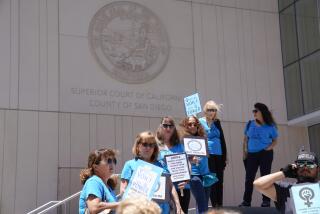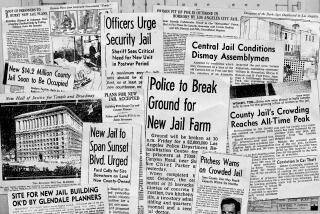Overflowing Jail Spills Suspects on the Street : Sheriff: Cite-and-release policy means many walk free, including those accused of violent crimes.
- Share via
SANTA ANA — Driving drunk is a crime, especially if you do it with your license suspended and commit a hit-and-run in the process. But in Orange County, even that combination of offenses won’t necessarily land you in jail for a night.
Neither will burglary, prostitution, possession of an illegal substance or assault and battery, among a bevy of other violations. In fact, thousands of suspected law breakers, some of them charged with crimes of violence, walk free every year after agreeing to show up for their day in court.
Many of those released do as they are instructed, appearing before a judge at the appointed time to face the possibility of conviction and sentencing. But thousands--60% in one recent three-day sample--take their freedom and run, and they have to be re-arrested. Some even fail to show up after being arrested a second time and released again--all because of overcrowding in the county jails.
The cycle of arrest, failure to appear and re-arrest is costing county taxpayers and putting suspects, most of them accused of petty crimes, back on the street. It’s snarling the courts and, according to officials, encouraging criminals to think that they can get away with--if not exactly murder--at least an array of less serious offenses.
It adds up to a system of justice that gives local police and judges fits.
“It’s ridiculous. Nobody benefits, and it promotes the public’s disregard of the judicial system,” said Municipal Judge Richard W. Stanford Jr., an outspoken critic of the early release programs. “It just continues to get worse and worse.”
Even Sheriff Brad Gates, who initiated the early release and so-called “cite-and-release” programs in 1986, confesses that he’s no great fan of letting prisoners go before their time is up.
“These are all very heart-wrenching, difficult decisions for me to make,” Gates said in an interview last week. “When you’ve been on the street and you know what those officers need, you don’t want to let guys who they arrest go. It can be very demoralizing.”
Controversial from the moment it began, the two early-release programs--which together have let about 170,000 people go since 1986--have emerged as the most inflammatory side effect of the county’s longstanding battle against jail overcrowding. And, since overcrowding shows no signs of abating, neither do the release programs.
In large measure, the release programs are controversial because they threaten law-abiding citizens in a way that jail overcrowding normally does not.
Overcrowding adds to the stress of being a deputy and threatens to violate the constitutional rights of inmates, some of whom are awaiting trial and have never been convicted of a crime. Both of those are serious problems with important legal and social consequences, but both occur inside the jail walls, which makes them harder for many people on the outside to appreciate.
Cite and release, on the other hand, puts criminal suspects on the streets. The result: It hits people where they live.
“People always complain about putting a jail in their backyard,” said Assistant Sheriff Rocky Hewitt, echoing a thought mentioned frequently by Gates. “But because we don’t have a jail, we’re being forced to release thousands of criminals every year into everybody’s back yard.”
As controversial as cite and release is, those who administer it argue that at least in the short run, it works. It means that more than 20,000 suspects a year who might have spent a night in jail do not, and that means the jails have room to house that many more serious violators.
That gain comes at great cost, however, and judges and other observers say the system is an unmitigated disaster, one that breeds contempt for the courts and the police. Indeed, police chiefs of several Orange County cities said it is badly undermining their efforts.
“It’s common knowledge out there that there are some crimes that you won’t be arrested for,” said Santa Ana Police Chief Paul M. Walters. “I think you’re sending a signal to that segment of the community that they’re going to be virtually immune.”
Garden Grove Police Chief John Robertson agreed, and said cite and release has been particularly damaging to his department’s campaign for the trust of Vietnamese and Koreans living in the city. Those residents, many of them immigrants, are reluctant to report crimes to the police, Robertson said, and have to be persuaded that doing so will get a criminal off the streets.
“Finally we get them to report it, we arrest, and boom, the person is back in a few hours,” Robertson said. “The little gangsters come back and say they own the police. That makes our job pretty difficult.”
Indeed, what can be particularly stunning about cite and release is how quickly an arrested person spins through a system that is known for its backlogs and delays. Thousands of suspects actually are released by the arresting officer, and they may never even get as far as the inside of a police car.
Others come all the way into the county’s Intake-Release Center, but unless they are held to sober up or be given other medical attention, they too often are right back out on the street.
“It’s just a matter of hours,” Robertson said. “They’ll be gone just before dinner, and back by the time dessert is served.”
Even in serious cases, the process can move with great speed. A handful of samples provided by the County Sheriff’s Department illustrate the quickness with which an arrestee, even one with a criminal history, can bounce out of the system:
* “A 30-year-old man from Garden Grove, whose criminal history includes multiple convictions for robbery, burglary and possession of drugs and hypodermic needles, was booked into the Orange County Jail in May for vandalizing his mother’s Irvine residence and later making phone calls threatening to burn it down,” states one of the cases, which officials provided to The Times. “Although he had assaulted his mother on several previous occasions, he was released from custody the same day he was arrested for lack of jail space.”
* In a case involving drunk driving: “A 38-year-old man was arrested for drunk driving and a hit-and-run on Newport Avenue in Costa Mesa,” the sheriff’s report states. “Despite the fact that he had a suspended license, no insurance, four previous DUI (driving under the influence of alcohol) arrests, an arrest for battery, and convictions for prostitution and spouse-beating, he was released from the Orange County jail the same day he was arrested because there was no room to hold him.”
* And in Buena Park, a 31-year old man was arrested for aggravated assault and battery against a 39-year-old woman. “Although the man’s criminal history included arrests for murder, assault with a deadly weapon and being under the influence of a controlled substance, and although he had been convicted of assault once before, he was released from the Orange County Jail the same day because there was not enough room to hold him.”
Sheriff’s officials supplied several other such examples, but would not release the names of the suspects involved.
The number of cite-and-release cases are a matter of public record, however, and they show a steady increase since 1986. In that year, 8,443 prisoners were released under the program, though it was only in place for part of the year. In 1987, its first full year, 23,351 were released, and that had grown to 28,635 last year.
With those kinds of numbers, sheriff’s officials warn that it’s only a matter of time before the problem explodes.
“It’s just a daily crisis,” said Capt. William Miller, who oversees the Intake-Release Center in Santa Ana. “We don’t want to release anyone that we absolutely don’t have to. I mean, not only are we cops, who don’t like releasing people who should be here. But we’re also people out in the community with our own families. We don’t want these people out in the community either. . . . Someday, the wrong guy is going to get out there.”
Partly because it’s a program born of necessity and disliked even by those who administer it, cite and release has also brought together some unlikely bedfellows.
Stanford, who has threatened Gates with contempt charges for administering the program, agrees with the sheriff that it’s a bad system. The American Civil Liberties Union, which represents inmates, has filed a motion in federal court that would protect Gates from such a contempt charge.
That motion represents the rare issue on which Gates and the ACLU find themselves on the same side. They have tangled in court for more than a decade as the ACLU has pressed its cases against the way the county jail system is managed.
The county supervisors stand uncomfortably at the vortex of the issue, unable or unwilling to settle on a plan for building a new jail or develop an alternative that would reduce the county’s inmate population. Their deadlock is what lays the groundwork for cite and release, but they, too, wish it didn’t exist.
“I don’t like it any better than anybody else,” said Supervisor Don R. Roth, chairman of the county board. “There’s always a danger if a man is convicted and isn’t asked to serve his time.”
But, Roth adds, “you have to remember that the (suspects in) major crimes are not being released.”
That’s often noted by county officials outside the Sheriff’s Department: some of them privately grouse that Gates uses cite and release to inflame public sentiment and pressure the supervisors to build a jail.
And for the most part, the observation is true. Most of the people released under the sheriff’s cite-and-release program are at best a minor threat to public safety. Drunk drivers top the list: 11,669 were released last year after spending just long enough in jail to sober up. As of Nov. 11 this year, 11,005 have been released.
Other assorted traffic violations also figure prominently in the program, as do various low-grade misdemeanors.
But they don’t make up the whole picture. When the jails grow especially crowded--on Friday nights, for instance, when prisoners who have been sentenced to serve their time on weekends show up and join the regular flow of rowdies--more serious misdemeanor violators go free.
It’s also then that people re-arrested on bench warrants--issued by a judge, usually against suspects who have already failed to appear in court--are turned around and pointed back out the door. Since they have already disobeyed a court once, the likelihood that they’ll appear as ordered is considered slim.
They’re the ones most likely to have to be re-arrested, and once they are they’ll be charged with failure to appear in addition to their original offense. So if they are eventually convicted, they’ll likely face a longer sentence, an outcome that only adds to overcrowding.
Nor does the controversy about releasing prisoners end with cite and release. Even those criminals who get further into the system, who have their cases heard by a judge and are sentenced to do jail time, will get out early.
Gates is authorized by the Superior Court “from time to time to release prior to the end of their sentences those prisoners with the shortest remaining periods of incarceration in a number sufficient to keep the jail population within the limits authorized under the U.S. Constitution.”
As overcrowding has become endemic, “from time to time” has come to mean almost every day.
With the exception of Central Men’s Jail in Santa Ana, where a federal court order caps the population, every county facility is badly overcrowded. The county has double-bunked most cells, put in tents and mobile homes and even resorted to using medical beds to house healthy inmates.
When all that is exhausted, as it is almost every night, the deputies in charge of managing the system start releasing inmates early.
So-called “early outs” are picked by lopping off time for good behavior and more time for work performed on jail crews. Moreover, virtually every male prisoner gets 10% of his sentence reduced for no reason other than the sheriff needs his bed.
That’s meant that sentences are dramatically shorter in many cases. So much so that it’s created new levels of gamesmanship in the courts.
“I can offer a defendant the choice of a $30 fine or a day in jail,” Judge Stanford said. “And you’d expect they’d pay the fine. But people now would rather take the day in jail because they know they’ll never serve it. They’ll just be released.”
Same holds true for other attempts at creative sentencing, Stanford said. Offer defendants the choice of a long stint performing volunteer service or a short one in jail, and they’ll take jail because they’ll be out in a jiffy, he said.
“The whole thing becomes absurd,” Stanford added. “How do we get these guys to pay their fines when they know they won’t serve any time if they refuse?”
To compensate for early releases, judges have engaged in a tactic of their own. They increase their sentences, so that when the sheriff knocks of 10%, the inmate has already served as long as the judge wanted him to.
From there, the next step is obvious: Gates goes back and raises the 10% reduction to 20%. If it sounds like one-upmanship, it is. Both sides of the game admit it, and yet both defend their moves by saying it’s all they can do to comply with the law.
Where will it end? So far, no one has stepped forward with an answer.
“We don’t like releasing people any better than the judges do,” Gates said. “But we don’t have any choice, and until we have some jails to put these people in, we’re going to have to keep releasing them.”
ORANGE COUNTY JAIL SYSTEM INMATE PROFILE Through Nov. 14, 1990 Who’s Behind the Bars RESIDENCY Orange County Residents: 4,192 Non-Orange County Resident: 1,452 AGE under 18 years: 14 18-24 years: 1853 25-30 years: 1660 31-40 years: 1537 41-55 years: 508 over 56 years: 72 RACE White: 2659 Latino: 2471 Black: 341 Chinese: 22 Vietnamese: 48 Other: 103 The Cite-and-Release Cycle Breaking the law might get you arrested, but it won’t get you a full sentence, since overcrowding has forced the sheriff to develop all kinds of ways to get you out make room for the next batch of criminals. 1. Arrest If you’re charged with a misdemeanor, chances are you’re still not headed for jail. The arresting officer will likely issue you a citation and tell you when to show up in court. You’re expected to be there, or you’ll face more charges. 2. Receiving If you’re brought into the county’s Intake-Release Center, you’re going to be in for at least a couple hours. On a busy night, the receiving deputy will have to turn away dozens of arrestees to make room for more serious criminals. If you’re what they call “a keeper,” they have 24 hours to find you a bed. 3. Detention-release Here a court official will interview you, ask about your record and assess the seriousness of your crime. If this officer thinks your crime is too petty to spend the night, he’ll set you free. 4. Classification This deputy wants to know more about your past. If you’ve gotten this far, you’re probably headed for jail, but overcrowding could still get you off. As the evening goes on, criminals are rolling in behind you, and some of them may deserve the stay more than you. 5. Jail-pre trial Once you’ve gotten through booking, you’re headed for jail. You’re not entitled to much during your time behind bars, but they’re under orders to give you eight hours of uninterrupted sleep the night before you see a judge. 6. Jail-sentenced prisoners If you’ve gone before a judge and he’s sentenced you to jail, you’ll arrive that evening on a bus full of criminals. But you’re not going to serve your full time. Prisoners routinely get 10% chopped from their sentence, and good behavior or work time will cut that even further. Leading Cite-and Release Arrests Crime: Number 1. Driving under the influence: 11,005 2. Miscellaneous traffic: 5,024 3. Petty theft: 748 4. Assault and battery: 488 5. Under the influence of a controlled narcotic or PCP: 454 6. Resisting arrest: 365 7. Prostitution: 281 8. Trespass: 223 9. Drunk in public: 163 10. Vandalism: 120 Smaller numbers of people charged with crimes such as burglary, grand theft and carrying a concealed weapon are also released every year. WHAT THEY’RE IN FOR According to the charge profile report for all facilities as of Nov. 14: FELONIES
Awaiting Trial Sentenced Total Murder 113 13 126 Manslaughter 4 4 8 Attempted Murder 64 34 98 Kidnap 46 11 57 Robbery 102 65 167 Assault w/Deadly Weapon 73 55 128 Rape/Sexual Assualt 16 6 22 Abuse--Child/Spouse 21 36 57 Child Molest 43 30 73 Burgulary 263 355 618 Forgery 16 32 48 Grand Theft 64 84 148 Stolen Property 71 109 180 Having Marijuana 27 36 63 Having Drugs 432 442 874 Using Drugs 61 293 354 Grand Theft Auto 22 52 74 Parole/Probation Violation 145 560 705 Other Felonies 66 55 121 TOTAL FELONIES 1649 2272 3921
MISDEMEANORS
Awaiting Trial Sentenced Total Assault/Battery 24 29 53 Prostitution 12 13 25 Non-Support 2 5 7 Indecent Exposure 1 2 3 Petty Theft 39 93 132 Vandalism 12 19 31 Trespass 4 10 14 Drunk/Disorderly 13 22 35 Drunk Driving 182 572 754 Other Misdemeanors 158 452 610 TOTAL MISDEMEANORS 447 1217 1664 GRAND TOTAL 2096 3489 5585
Source: Orange County Sheriff’s Department
More to Read
Sign up for Essential California
The most important California stories and recommendations in your inbox every morning.
You may occasionally receive promotional content from the Los Angeles Times.











